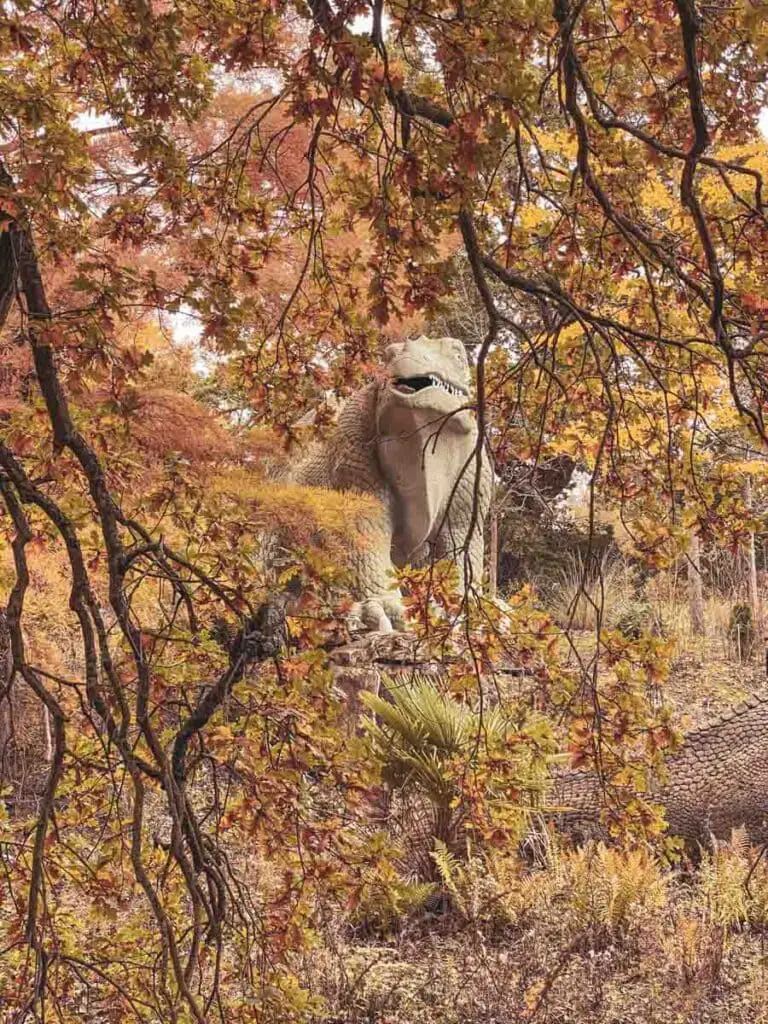The history of the Iguanodons at Crystal Palace Park and the rapid discoveries that put them out of date almost immediately.
We’ve written before about our love of the Crystal Palace Park Dinosaurs. They’re a wonderful part of the rich history of London.
Even the members of our team who didn’t grow up in the capital remember coming here as kids and marvelling in awe of the bizarre beasts, a London dino experience only overshadowed by terrifying encounters with the animatronic T-Rex at the Natural History Museum.
Of the many sculptures at Crystal Palace Park, there are two that have a pretty curious history. They would be the iguanodons. Why are they curious? Even as kids we could tell the designer got them almost entirely wrong…
Why Visit The Iguanodons?

We have to say that all of the park’s dinosaur sculptures are well worth a visit for their quirky charms, but the iguanodons are especially worth noting.
Bizarre-looking and utterly unlike anything that we’d associate with the beast today, they look much more like something you’d find at the zoo than in Jurassic Park. The story behind them is also a great reminder of how the facts can change.
The History of the Dino Park’s Iguanodons and the Discoveries that Rewrote Their Telling of History

The iguanodon sculptures arrived in Crystal Palace Park in the 1850s. To throw a little context on this, the word dinosaur had only been invented about 15 years earlier. The whole concept of a being as old as these was in stark contrast to the widely held belief that God created everything.
The dino sculptures were to be a metaphor for the ingenuity of Victorian society, a symbol of its scientific, enlightened thinking. The man who designed them, Benjamin Waterhouse Hawkins, was a model of that ethos too. But he would live to see that scientific thinking prove him wrong.
Dino Design

You probably can’t help but look at the iguanodon sculptures and think that looks nothing like the animals I’ve seen on TV. You’d also be right in thinking that they look an awful lot like the kind of lizards you can find on Earth today (if only a little bit larger).
That’s because when Hawkins was designing the iguanodons he was doing so largely out of conjecture. He’d have known that the bones he was dealing with were that of a reptile but the general shape would have been a mystery to him.
To compound matters, the biggest reptiles Hawkins would have had knowledge of would have been low-slung creatures like crocodiles, komodo dragons, monitor lizards and (this is key) iguanas. The idea of a lizard that walked on two feet would have seemed like nonsense to him.
Then there was the matter of that horn. Any dinosaur-obsessed kid these days can tell you that iguanodon’s horn belongs on its thumb. You’ll see that the iguanodons at Crystal Palace Park have it placed on their heads.
Dino Discovery

Within Hawkins’ lifetime, further iguanodon would be unearthed around the world which would change the way we understand what the prehistoric reptiles looked like.
The first of these came just 20 years after Hawkin’s iguanodons were unveiled. It was in the 1870s with the theory that iguanodons had a ‘kangaroo-like posture’, though this was later to be proved wrong too. Iguanodon would much later on be found to walk on all fours though not in the way that Hawkins had imagined.
It wasn’t until 1878 that the iguanodon spike was agreed to come from its thumb, not its nose. By this point, the dinosaurs at Crystal Palace Park were so treasured that nobody wanted to change them.
So What did Hawkins Get Right?

There is one thing that Hawkins got spot on about the iguanodon and that’s its scaly skin. Though he wouldn’t have known it at the time, fossils have since been found of dinosaurs closely related to iguanodon that show reptilian skin patterns just like the ones on Hawkins’ sculptures.
These days more and more scientists are speculating about dinosaurs having feathers though, so who knows how long scaly skin will remain the commonly accepted truth…
Crystal Palace Park Dinos: Practical Information
Address: Crystal Palace Park, Thicket Rd, London SE19 2GA
Opening Times: Open from 7:30am on weekdays and 9:30am at weekends. The park closing times change throughout the year. You can find info on closing times here.
Tickets: The park is free to enter and there’s no charge to see the dinosaurs.
Crystal Palace Park: Map
Read More of London’s Curious History
- The History of London’s Roman Amphitheatre and the Unlikely Story of How it was Discovered
- The Murky History of Lincoln’s Inn – One of London’s Oldest Surviving Institutions
- Kingswood House: The Landed Home that Went From Country Estate to Council Estate
- The History of The Knights Templar in London and What this Mysterious Military Order Left Behind

